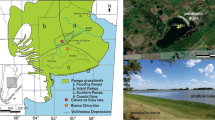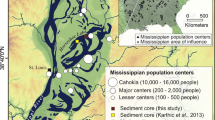Abstract
The recent history of Little Round Lake, a small meromictic lake in southeastern Ontario, is considered. Pollen analyses were used to identify past changes in terrestrial vegetation, whilst limnological conditions were interpreted on the basis of diatom and chrysophyte microfossils. Contemporaneous with the arrival of European settlers (ca. A. D. 1850), the predisturbance assemblage of oligotrophic Cyclotella diatoms was replaced by Synedra spp., which then succeeded to a eutrophic flora dominated by Stephanodiscus hantzschii. Meanwhile, synuracean algae were almost completely excluded. Over the last 30 years, the algal microfossils indicate that the lake underwent a marked return to oligotrophy. Evidence is presented which suggests that this shift was related to the cultural enhancement of meromixis by the seepage of road salt.
Similar content being viewed by others
References
Asmund, B. & Hilliard, D. K., 1961. Studies on Chrysophyceae from some ponds and lakes in Alaska. I. Mallomonas species examined with the electron microscope. Hydrobiologia 17: 237–258.
Bassett, I. J. & Terasmae, J., 1962. Ragweeds, Ambrosia species in Canada and their history in post-glacial time. Can. J. Bot. 40: 141–150.
Battarbee, R. W., 1973. A new method for the estimation of absolute microfossil numbers, with reference especially to diatoms. Limnol. Oceanogr. 18: 647–653.
Bradbury, J. P., 1975. Diatom stratigraphy and human settlement in Minnesota. Geol. Soc. Spec. Pap. 171: 1–74.
Brown, S. R., 1956. A piston sampler for surface sediments of lake deposits. Ecology 37: 611–613.
Brown, S. R., Daley, R. J. & McNeely, R. N., 1977. Composition and stratigraphy of the fossil phorbin derivatives of Little Round Lake, Ontario. Limnol. Oceanogr. 22: 336–348.
Brugam, R. B., 1978. Pollen indicators of land-use change in southern Connecticut. Quat. Res. 9: 349–362.
Brugam, R. B., 1979. A re-evaluation of the Araphidineae/-Centrales index as an indicator of lake trophic status. Freshwat. Biol. 9: 451–460.
Cleve-Euler, A., 1951–1955. Die Diatomeen von Schweden und Finnland. K. svenska Vetensk. Akad. Avh. 5: 1–232.
Cronberg, G. & Kristiansen, J., 1980. Synuraceae and other Chrysophyceae from Central Småland, Sweden. Bot. Notiser 133: 595–618.
Daley, R. J., Brown, S. R. & McNeely, R. N. 1977. Chromatographic and SCDP measurements of fossil phorbins and the post glacial history of Little Round Lake, Ontario. Limnol. Oceanogr. 22: 349–360.
Dean, W. E. Jr., 1974. Determination of carbonate and organic matter in calcareous sediments and sedimentary rocks by loss of ignition: Comparison with other methods. J. Sediment. Petrol. 44: 242–248.
Faegri, K. & Iversen, J., 1975. Textbook of pollen analysis. Blackwell scientific Publications, Oxford. 295 pp.
Fast, A. W., & Wetzel, R. G., 1974. A close interval fractionator for sediment cores. Ecology 55: 202–204.
Huber-Pestalozzi, G., 1942. Das Phytoplankton des Süsswassers. Binnengewasser 16: 367–599.
Hustedt, F., 1930–1966. Die Kieselalgen Deutschlands, Österreichs und der Schweiz. In: Rabenhorst, L., (Ed.), Kryptogamen-Flora, Verlag von J. Cramer, Leipzig. 556 pp.
Lowe, R. L., 1975. Comparative ultrastructure of the valves of some Cyclotella species (Bacillariophyceae). J. Phycol. 11: 415–424.
McNeely, R. N., 1973. Limnological investigations of a small meromictic lake, Little Round Lake, Ontario. Ph.D. thesis, Queen's University, Kingston. 185 pp.
Munch, C. S., 1980. Fossil diatoms and scales of Chrysophyceae in the recent history of Hall Lake, Washington. Freshwat. Biol. 10: 61–66.
Munro, K. A., 1978. Phytoplankton dynamics in meromictic Little Round Lake, southeastern Ontario, with emphasis on growth of Cryptomonas rostratiformis in nature and in culture. M.Sc. thesis, Queen's University, Kingston. 154 pp.
Nygaard, G., 1956. Ancient and recent flora of diatoms and Chrysophyceae in Lake Gribsø. Folia limnol. scand. 8: 32–262.
Patrick, R. & Reimer, C. W., 1966. The diatoms of the United States. 1. Fragilariaceae, Eunotiaceae, Achnanthaceae, Naviculaceae. Acad. nat. Sci., Philadelphia. 688 pp.
Patrick, R. & Reimer, C. W., 1975. The diatoms of the United States. 2 (1). Entomoeidaceae, Cymbellaceae, Gomphonemaceae, Epithemiaceae. Acad. nat. Sci., Philadelphia. 213 pp.
Rowe, J. S., 1959. Forest regions of Canada. Dep. northern Affairs nat. Res., Ottawa. 172 pp.
Smol, J. P., 1980. Fossil synuracean (Chrysophyceae) scales in lake sediments: a new group of pale oindicators. Can. J. Bot. 58: 458–465.
Smol, J. P., 1981. Problems associated with the use of `species diversity' in paleolimnological studies. Quat. Res. 15: 209–212.
Smol, J. P. & Dickman, M. D., 1981. The recent histories of three Canadian Shield lakes: A paleolimnological experiment. Arch. Hydrobiol. 93: 83–108.
Stoermer, E. F. & Yang, J. J., 1969. Plankton diatom assemblages in Lake Michigan. Univ. Mich. Great Lakes Res. Div. Spec. Pap. 47, Ann Arbor. 268 pp.
Takahashi, E., 1978. Electron microscopical studies of the Synuraceae (Chrysophyceae) in Japan. Tokai University Press, Tokyo. 194 pp.
Tarapchak, S. J., 1973. Studies of phytoplankton distribution and indicators of trophic state in Minnesota lakes. Ph.D. thesis, Univ. Minn. Minneapolis. 227 pp.
Tippett, R., 1964. An investigation into the nature of the layering of deep water sediments in two eastern Ontario lakes. Can. J. Bot. 42: 1693–1709.
Vallentyne, J. R., 1960. On fish remains in lacustrine sediments. Am. J. Sci. 258: 344–349.
Vallentyne, J. R., 1963. Isolation of pyrite spherules from recent sediment. Limnol. Oceanogr. 8: 16.
Whittaker, J. R. & Vallentyne, J. R., 1957. On the occurrence of free sugars in lake sediment extracts. Limnol. Oceanogr. 2: 98–110.
Author information
Authors and Affiliations
Rights and permissions
About this article
Cite this article
Smoll, J.P., Brown, S.R. & McNeely, R.N. Cultural disturbances and trophic history of a small meromictic lake from central Canada. Hydrobiologia 103, 125–130 (1983). https://doi.org/10.1007/BF00028439
Issue Date:
DOI: https://doi.org/10.1007/BF00028439




